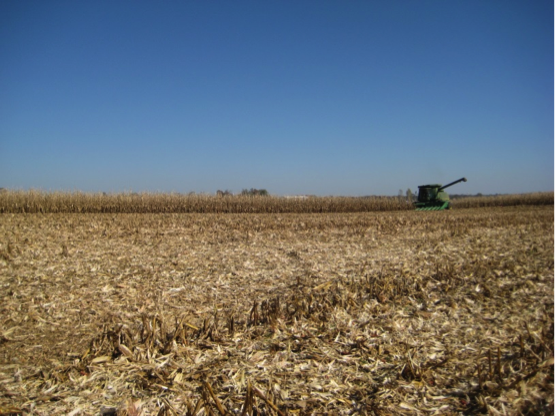Grazing Corn Residues

Grazing remaining residue following corn harvest is one way to extend the grazing season and lower feed costs. Winter feed costs are the largest expense and grazing corn residues offers a way to significantly reduce those costs. According to the Iowa State University Beef Cattle Center, for every acre of corn residues grazed, approximately a ½ ton of hay will be saved. Grazing crop residues will not impact crop yield the following year. Also, adequate residue is left on the field to reduce soil erosion.
By grazing crop residues, you are utilizing an abundance of forage that would otherwise be unused. For every bushel of corn harvested, typically 50 pounds of residue is left in the field. Corn residue includes the stalk, leaf, husk and cob, and downed ears. Cattle are selective grazers, and will eat any leftover corn first, then the leaf and husk material. They will consume only a limited amount of coarse stalk. It can be expected for cattle to consume 25% of available residue after selection and loss from weathering and trampling. The University of Nebraska has developed a spreadsheet tool that will calculate the acres of crop residue needed for the cow herd. They suggest 1.5 animal unit (1000 lbs of body weight) months (AUMs) per acre is an appropriate stocking density on crop land that yields near 240 bu/acre. This would be the equivalent of one average beef cow per acre per month.
Crop fields are usually not fenced, so the cost of grazing residues is dependent upon fencing and water supplies needed, which will vary with the type and amount of fencing used. Perimeter high tensile wire, temporary fencing, and temporary water tanks may be options to quickly make a field available to cattle. Be sure to comply with Kentucky Fencing Laws, KRS 256, when putting in new fencing. The length of time available to graze crop residue will vary due to location, weather, and amount of available forage. In Kentucky, there can be fear of compaction due to the freeze/thaw patterns of the soil and less days of hard, frozen ground. Compaction can be reduced if producers graze animals soon after harvest in November, and remove animals by mid-December before the wetter months.
Corn residue is low in protein, most minerals, and vitamin A. Dry beef cows in mid-gestation that are in good flesh are the best class of animals to utilize crop residues as they have lower nutritional requirements. Nutritional requirements may be met early after turnout, being that cattle will selectively graze residues with high digestibility and corn left in the field first. During this time, only a complete mineral and vitamin supplementation product should be needed. With time, the combination of weathering and consumption of high quality residues leads to quality deterioration of the available residue. The rate of quality deterioration will depend on stocking rate and environmental conditions. Also, as the cow’s gestation period progresses, nutrient requirements increase while the quality of crop residues are decreasing. Protein and possibly energy supplementation will be needed along with a high quality mineral and vitamin supplement. This can be achieved using a variety of supplements, but some common ones include alfalfa hay, soybean meal, distiller’s grains, and commercial supplements.
Before grazing crop residues, be sure to check the labels of previously used pesticides to be sure they are cleared for grazing. Strip grazing is recommended to increase grazing days and efficiency. Strip grazing is achieved by fencing off a portion of the field with electric fence to reduce selective grazing and utilize corn residue more efficiently. The fence is then moved to provide access to more of the field, and so on. Strip grazing will also help to control grain consumption. This is important as excessive amounts of grain can increase the risk of inducing digestive upsets and possibly lead to acidosis and foundering cattle. To reduce this risk, gradually adapt cattle to grain prior to turnout, don’t turnout hungry cows into a field of corn residue, and observe cattle regularly for the first few days of grazing.
In summary, grazing crop residues offers potential for extending the grazing season and reducing feed costs. Dry mid-gestation cows graze crop residues well as they have lower nutritional requirements. Be sure to provide a vitamin and mineral supplement when grazing crop residues. As plant quality decreases, protein and energy supplementation will be needed.
Categories:
Fall
Extending the Grazing Season


